Kristine Hughes's Blog, page 161
January 24, 2011
Do You Know About the Forsyte Saga?
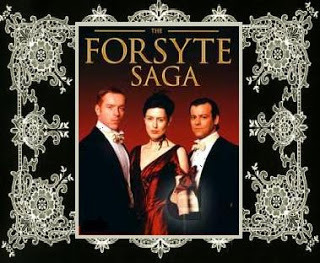
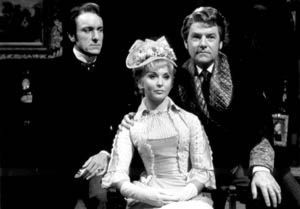
While Downton Abbey has recently premiered on Masterpiece Theatre, we thought we'd tell you about another great period drama, The Forsyte Saga. Whether, like me, you prefer the older version (1967) or the new (2002), settling in to watch the Forsyte Saga is like snuggling up with a brandy in front of the fire - comfortable, cosseting and considerably entertaining. Like all good costume dramas, the Forsyte Saga provides romance, drama and skull duggery based on a series of three novels - The Man of Property, In Chancery and To Let -and two interludes published between 1906 and 1921 by author John Galsworthy, who won the Nobel Prize for Literature in 1932. The twenty-six episodes cover the history of the aristocratic Forsyte family between the years 1879 and 1926. You should be aware that the 2002 version only covered the first two of Galway's novels and only ran for seven episodes. The plot revolved around the feuds and machinations of the Forsyte family and their London merchants' business, with each episode culminating in a melodramatic cliffhanger ending. Together with the fact that the original version was filmed in black and white, the series has a decidedly "soap opera" feel to it, and we say Bravo!
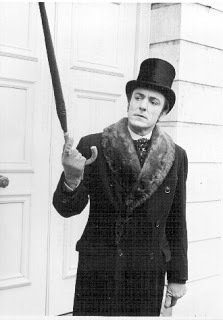 The Forsyte Saga chronicles the ebbing social power of the upper-middle class Forsyte family through three generations, beginning in Victorian London during the 1880s and begins with Soames Forsyte (right, played by Eric Porter), a successful solicitor who buys land at Robin Hill on which to build a house for his wife Irene and future family. Little does he suspect (at first) that Irene has only married him for his money. Beneath his very proper exterior lies a core of unhappiness and a string of brutal relationships. Eventually, the Forsyte family begins to disintegrate when Timothy Forsyte, the last of the old generation, dies at the age of 100. Soames' cousin Jolyon abandons his distraught wife and won't see his children again for some years, whilst architect Philip Bosinney, besides having an affair with Irene, plays fast and loose with Soames' money while building him a house.
The Forsyte Saga chronicles the ebbing social power of the upper-middle class Forsyte family through three generations, beginning in Victorian London during the 1880s and begins with Soames Forsyte (right, played by Eric Porter), a successful solicitor who buys land at Robin Hill on which to build a house for his wife Irene and future family. Little does he suspect (at first) that Irene has only married him for his money. Beneath his very proper exterior lies a core of unhappiness and a string of brutal relationships. Eventually, the Forsyte family begins to disintegrate when Timothy Forsyte, the last of the old generation, dies at the age of 100. Soames' cousin Jolyon abandons his distraught wife and won't see his children again for some years, whilst architect Philip Bosinney, besides having an affair with Irene, plays fast and loose with Soames' money while building him a house.A much darker and condensed version of the novels appeared in the movie That Forsyte Woman (1949), which starred Errol Flynn as Soames, Greer Garson as Irene, Walter Pidgeon as young Jolyon, Robert Young as Philip Bosinney and Janet Leigh as June.
In his novels, Galsworthy documented a departed way of life, that of the affluent middle class that ruled England before the 1914 war. Galsworthy's masterly narrative examines not only their fortunes but also the wider developments within society, particularly the changing position of women. Honestly, you'll find yourself cheering for the good guys, absolutely loathing Soames and losing patience with the aristocratic ladies who fail to hear you yelling at the screen, "For God's sake, speak up, walk out, do something!"
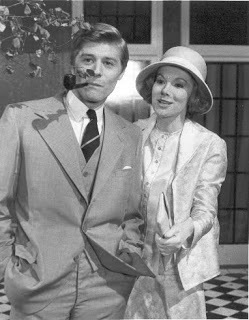
One of our favorite acresses, Susan Hampshire (Monarch of the Glen), plays Fleur in the original version. The series attracted no less than six million viewers on its first showing and when repeated on BBC1 the following year, a staggering 18 million people tuned in. The success of the series, which won a Royal Television Society Silver Medal and a BAFTA award for Best Drama, prompted the BBC to plough further resources into similar blockbusting "costume" dramas, a strategy that would lead the production of such series as The Pallisers and Upstairs, Downstairs.
You can watch a bit of Episode One here.
Published on January 24, 2011 02:23
January 23, 2011
Spencer House
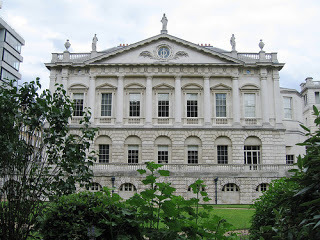
All of us are familiar with the name Spencer in the British aristocracy, e.g. Lady Diana Spencer, aka Diana, Princess of Wales; Winston Spencer Churchill; Georgiana Spencer Cavendish, Duchess of Devonshire; the Earls Spencer. It's an old and historic name and family. Spencer House was the London town house built in the 1750's by the 1st Earl Spencer; it is now owned by a corporation (headed by Lord Rothschild, to whom we must give thanks for its preservation and care). In the BBCTwo series by Amanda Vickery on Georgian Taste, the house and its principle rooms and furnishings were described as the epitome of Georgian style and elegance. The Spencer House website is here.
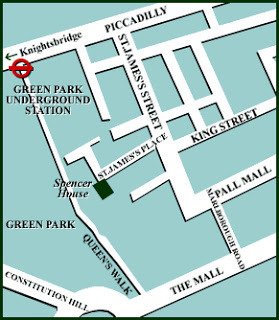
It isn't always easy to find the entrance. Though the west facade faces Green Park (above), you must wander around in the cluster of streets west of St. James's Street. There are several little twists or turns to take, but don't despair if you don't find it right away. The scenery is delicious -- and though there are few pedestrians or autos, the people watching CAN be excellent. Watch for top hats-- these will be the doormen at the hotel!
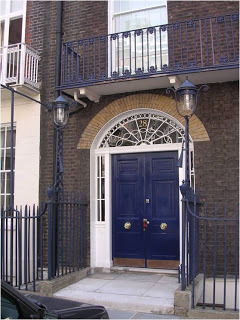
One day, on my way to Spencer House, I took this picture of a perfect
house in a row of 18th century buildings. It shows the torch snuffers on the lamp poles, for the footmen to extinguish their guiding torches after travel at night. Also, the fan light above the door would serve as an address before there were numbers on the houses. The picture of the unique fan light would be shown on your invitation to identify the proper venue!
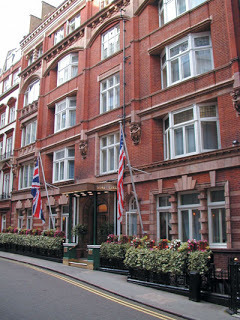 Also nearby, The Stafford Hotel
Also nearby, The Stafford HotelSomeday, I want to stay at the Stafford, a truly elegant establishment now part of the international Kempinski chain. I admit to entering its portals once to have a drink in the bar. Delicious.
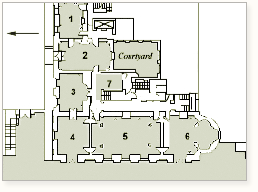 Here's a floor plan of the house. According to the guidebook, the house retains its essential Georgian neo-classical bones though it has been remodeled, renovated, updated and conserved many times over its many years. The basic layout was the design of John Vardy(1718-1765), a pupil of William Kent (1685-1748). The west façade facing into Green Park is almost entirely his work (as restored), and as such, it is one of the finest, most authentic examples of Imperial Roman architecture and one of the first built in 18th century England.
Here's a floor plan of the house. According to the guidebook, the house retains its essential Georgian neo-classical bones though it has been remodeled, renovated, updated and conserved many times over its many years. The basic layout was the design of John Vardy(1718-1765), a pupil of William Kent (1685-1748). The west façade facing into Green Park is almost entirely his work (as restored), and as such, it is one of the finest, most authentic examples of Imperial Roman architecture and one of the first built in 18th century England.
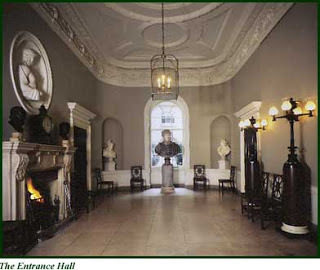
The ground floor contains the Entrance Hall, a morning room, library, and the principle dining room. The entrance hall is described as austere, in muted colors, with classical decorations based on Greek or Roman foundations. The relief over the fireplace portrays Antonius, a favorite of the emperor Hadrian, and one of the first pieces the 1st Earl Spencer purchased. Vardy is suppposed to have been responsible for most of the ground floor, with James "Athenian" Stuart taking over for the design and decoration of the first floor.
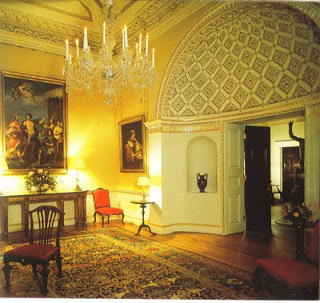
The ante room, left. Many of the furnishings and architectural details of Spencer House, such as fireplace surrounds, were removed to the Spencer country estate of Althorp during times of war or when the family leased out all or part of the building. Thus, some of the present furnishings are original, others exact copies of the originals, others similar to the originals, some purchased for the renovation, completed in 1989, and many more pieces on loan from the royal collection, the National Trust, the VandA, or other sources.
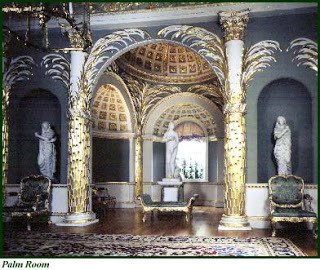 The Palm Room with its gilded columns and palm fronds is thought to be much as Vardy designed it, although many others have worked on the house. The chairs and benches are exact copies of Vardy's; the originals are now in the Museum of Fine Arts, Boston. The Medici Venus, in the central apse, was a very popular sculpture in the 18th and 19th centuries, one of the most graceful and beautiful statues copied or based on the Greek original, thought to be by 4th century B.C. master sculptor Praxiteles. Replicas can be found in stately homes, palaces, gardens, and museums worldwide. This copy was made by in white marble by Francis Harwood in 1765.
The Palm Room with its gilded columns and palm fronds is thought to be much as Vardy designed it, although many others have worked on the house. The chairs and benches are exact copies of Vardy's; the originals are now in the Museum of Fine Arts, Boston. The Medici Venus, in the central apse, was a very popular sculpture in the 18th and 19th centuries, one of the most graceful and beautiful statues copied or based on the Greek original, thought to be by 4th century B.C. master sculptor Praxiteles. Replicas can be found in stately homes, palaces, gardens, and museums worldwide. This copy was made by in white marble by Francis Harwood in 1765.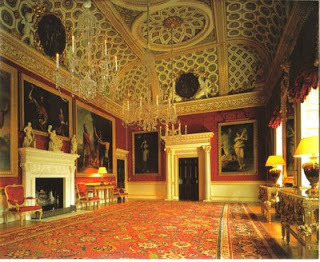
On the first floor, or piano nobile, the main rooms were meant to be impressive, yet welcoming; elaborate, yet comfortable; stunning, yet comprehensible to those who had enjoyed a classical education (as one might expect all who qualified to enter here to have had). The imposing Great Room is used for balls, for dining, or receptions. One can hardly imagine what luminaries of British politics and society graced it. Again, if only walls could speak. What did the Duke whisper to the Countess? And what did the Prime Minister confide to the Prince? And was that the dowager over there, winking at the handsome footman? My, my.
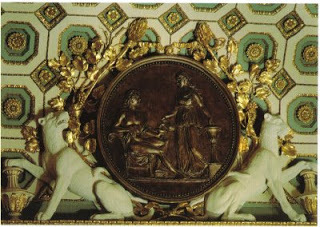 Great Room Ceiling medallion detail, right. The first floor and many of the details of the building were turned over by 1st Earl Spencer to James "Athenian" Stuart (1713-1788) well before the house was finished. And just a few years later, Henry Holland (1745-1806), who also was responsible for Brooks Club, various versions of Carlton House and the Marine Pavilion, redid some of the rooms. Both of them, as well as subsequent architects, basically respected the neo-classic character of the building, never resorting to Gothic or Oriental fads.
Great Room Ceiling medallion detail, right. The first floor and many of the details of the building were turned over by 1st Earl Spencer to James "Athenian" Stuart (1713-1788) well before the house was finished. And just a few years later, Henry Holland (1745-1806), who also was responsible for Brooks Club, various versions of Carlton House and the Marine Pavilion, redid some of the rooms. Both of them, as well as subsequent architects, basically respected the neo-classic character of the building, never resorting to Gothic or Oriental fads.
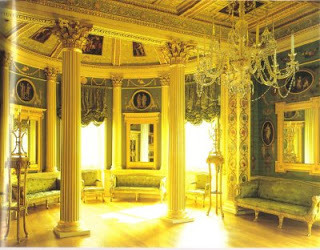 The Painted Room is the piece de resistance of the entire structure, executed by Athenian Stuart and fully restored to his designs. One of the most celebrated 18th C. interiors in Europe, the Painted Room actually changes according to variations in the light, both natural and artificial. The work took Stuart six years to complete; the designs celebrate the triumph of love, in honor of the happy marriage of the 1st Earl Spencer and his wife, Georgiana, nee Poyntz (parents of Georgiana, Duchess of Devonshire). On one panel, Venus is supposedly a portrait of the 1st Countess.
The Painted Room is the piece de resistance of the entire structure, executed by Athenian Stuart and fully restored to his designs. One of the most celebrated 18th C. interiors in Europe, the Painted Room actually changes according to variations in the light, both natural and artificial. The work took Stuart six years to complete; the designs celebrate the triumph of love, in honor of the happy marriage of the 1st Earl Spencer and his wife, Georgiana, nee Poyntz (parents of Georgiana, Duchess of Devonshire). On one panel, Venus is supposedly a portrait of the 1st Countess.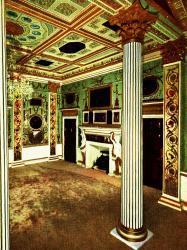 Here is another view of the Painted Room with different lighting and an angle which shows the ceiling, one of its most attractive features. Many of the paintings and sculptural features of the room are based on themes related to love and marriage from ancient Greece and Rome. Intertwining circles and vines are related to wedding rings, for example. Roses, wreathes and flower garlands relate to the same premises.
Here is another view of the Painted Room with different lighting and an angle which shows the ceiling, one of its most attractive features. Many of the paintings and sculptural features of the room are based on themes related to love and marriage from ancient Greece and Rome. Intertwining circles and vines are related to wedding rings, for example. Roses, wreathes and flower garlands relate to the same premises.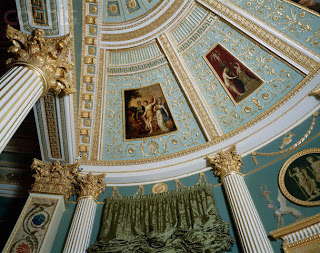 Another view of a detail of the Painted Room, showing the figures of loving couples from mythology and the elaborate decoration which covers the walls and ceilings.
Another view of a detail of the Painted Room, showing the figures of loving couples from mythology and the elaborate decoration which covers the walls and ceilings.Needless to say, this would be the perfect setting for a wedding, and the current owners would be delighted to arrange one. Just be sure the groom is a billionaire.

Now all you have to do, to prove your excellent Georgian taste, is to plan your special event, such as a grand ball, at Spencer House. Please don't forget to invite Kristine and Victoria. We'll be sure to attend!
And put the pictures right here.
Published on January 23, 2011 02:00
January 22, 2011
Queen Victoria - In Memoriam
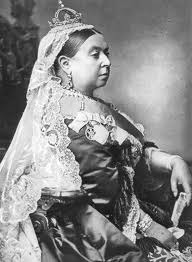
22 January 1901 - The death of Queen Victoria (Alexandrina Victoria German: Alexandrina Viktoria; B. 24 May 1819), who was the Queen regnant of the United Kingdom of Great Britain and Ireland from 20 June 1837, and the first Empress of India of the British Raj from 1 May 1876, until her death. Her reign as the Queen lasted 63 years and 7 months, longer than that of any other British monarch before or since, and her reign is the longest of any female monarch in history - Queen Elizabeth's reign is coming up on 59 years.
God save the Queen!
Another interesting aspect of Victoria's life was her role as a mother of nine and grandmother of dozens, In two generations. Her progeny ruled a huge chunk of Europe, not to mention the places where the sun never sets.
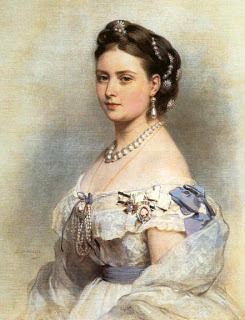 Right, the Princess Victoria, Princess Royal (1840-1901) was Queen Victoria's first born. She married German Emperor Frederick III and was the mother of Kaiser Wilhelm II and seven other children who married into a variety of Europoean royal families. This portrait was painted by Winterhalter in 1867 when she was Crown Princess of Prussia.
Right, the Princess Victoria, Princess Royal (1840-1901) was Queen Victoria's first born. She married German Emperor Frederick III and was the mother of Kaiser Wilhelm II and seven other children who married into a variety of Europoean royal families. This portrait was painted by Winterhalter in 1867 when she was Crown Princess of Prussia.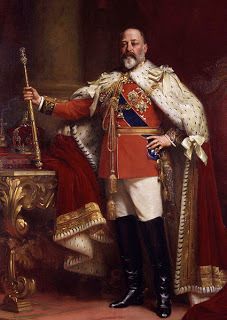 Edward Albert, Prince of Wales, and later Edward VII (1841–1910) was Victoria's second child, the longed-for male heir to the throne. He spent most of his life waiting to become king but he reigned only nine years after his mother's death in 1901.
Edward Albert, Prince of Wales, and later Edward VII (1841–1910) was Victoria's second child, the longed-for male heir to the throne. He spent most of his life waiting to become king but he reigned only nine years after his mother's death in 1901. He and his Queen, Alexandra of Denmark, had six children who also married royals.
Among the descendents of Queen Victoria are the royal families of the United Kingdom, Sweden, Norway, Denmark and Spain. Among those families formerly on thrones, count the ex-royals of Greece, Russia and Romania, not to mention a passle of former principalities.
Published on January 22, 2011 03:00
Artie-Facts
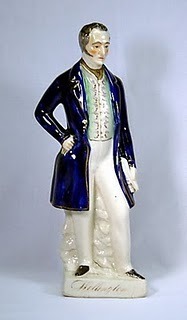
When in London recently, I once again visited Mark Sullivan Antiques in Cecil Court. And once again, Mark told me that I'd just missed seeing the current Duke of Wellington by a few days. Sigh. Mark and I chatted for a bit about Florida and we finally got down to the business of Artie-Facts, also known as Wellington commemoratives or memorabilia. There was nothing on hand that was as earth shattering as the Staffordshire figurine I'd purchased from Mark in June (above), so I was just about to reluctantly pass on buying anything when Mark told me that he had a few pieces in the basement that he'd been saving for a dealer, but seeing as how I was regular customer and the dealer was not, he'd bring them up for me.
The first item was the tankard below, made by Lambeth Potteries.
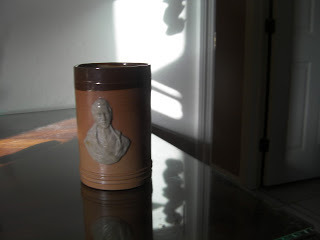
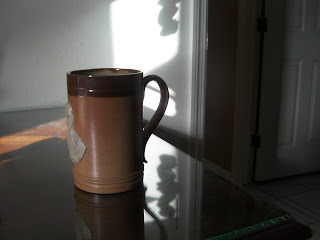
The second item was this small bust of the Duke of Wellington
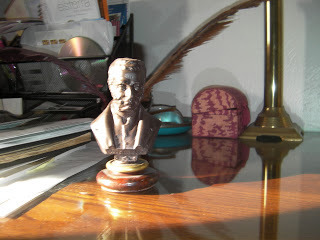
Reader, I purchased both. And, inspired by the display of commemoratives on show in the basement of Apsley House, I've grouped them all together with those pieces I already own in a lighted cabinet in the living room. You can read about my Wellington collection in a prior post here.
Published on January 22, 2011 01:20
January 21, 2011
Downton Abbey - The Series That Refuses to Die
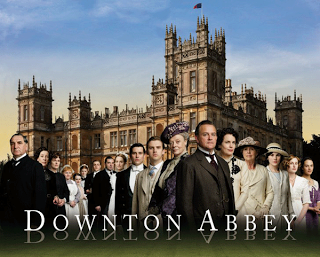
This topic will simply not go away. Are you ready for the latest? ITV has just announced that Downton Abbey - Series Two has been commissioned. The new eight-part series is expected to be broadcast next Autumn.
Unbelievable, right? Can you think of anything more unlikely - or unlikable? Well hold on to your mob caps, Downton Abbey will then return for Christmas 2011. The Christmas special will continue where the second series ends. I promise you I'm not making this up.
Gareth Neame, Executive Producer and Managing Director of Carnival Films says, "The public's reaction to the first series of Downton Abbey was gratifying. With a combined audience of 12.8 million people tuning into the last episode we are delighted ITV have decided to return with all the main characters of Downton at Christmas."
If that's not bad enough, Laura Mackie, Director of Drama, ITV said: "Julian has come up with a fantastic story that will give the audience the chance to enjoy the experience of the festive season at Downton Abbey. We're delighted to have this as part of our Christmas schedule for December 2011." I can't be certain, but with Fellowes writing the script, it's a good bet that the Christmas special might feature three ghosts. And a crippled youngster named Tim. Maybe even a kid who gets his tongue frozen to a pole. A lamp shaped like a woman's leg would be too much to hope for.
Here's something else that's funny (ironic, not ha-ha), "Downton Abbey premiered on ITV1 on 26th September 2010 with an aggregate audience of 11.8 million and finished on 7th November with an aggregate audience of 12.8 million (ITV1+HD+Repeat+ITV Player) making episode seven the biggest audience for an episode of a new drama series on any channel since 2003." I am still shaking my head over these numbers.
For an absolutely screamingly funny (ha-ha, not ironic) take on Part Two, read The 7 Reasons That Series Two of Downton Abbey Will Be Even Better here.
And to round out the bashing, you can read Rachel Cooke's reasons for being bored with DA in the New Statesman here. She sums them up rather well. If nothing else, DA has/is/will be breaking new television ground as no other show has before - it will be the first time in history that some part of the millions of those who tune in will be doing so in order to watch a programme they loathe. But which, you have to admit, can't help but to be screamingly funny.
In the interest of both turn-around and fairplay, you can read Julian Fellowes's take on all the DA bashing here.
Published on January 21, 2011 01:08
January 20, 2011
A Pictorial Stroll to Apsley House
Here we are together on another London stroll. This time, we'll be taking in the views as we approach Apsley House whilst walking north on Grosvenor Place.
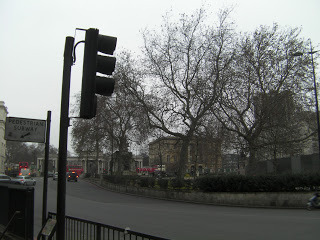
Our first glimpses of Apley House through the trees.
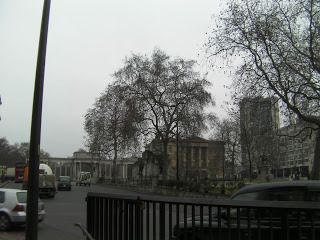
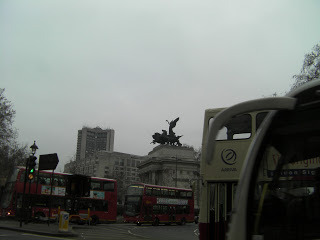
The Wellington Arch! And many double decker buses.
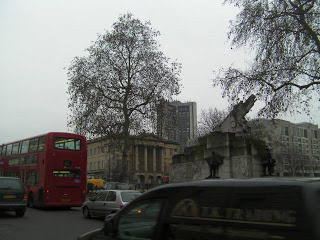
We're getting closer.
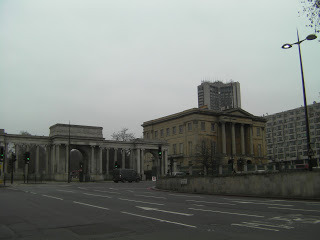
The gate at Hyde Park Corner, Apsley House and a rare break in the traffic.
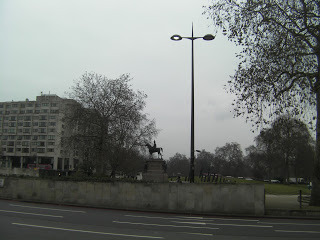
The Wellington Arch!
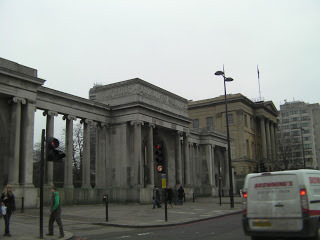
The gates at Hyde Park
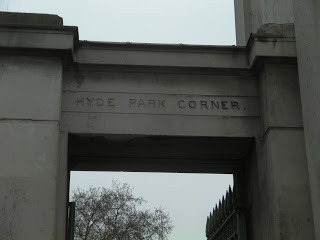
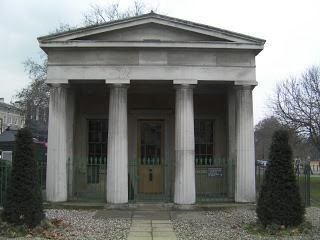
Stepping inside the gates, the toll keeper's cottage.
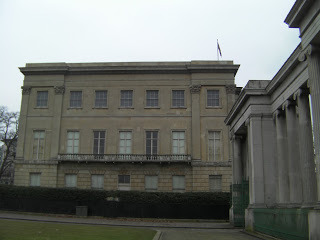
View from inside gates to the side of Apsley House. Wouldn't we look marvelous standing on that balcony with a cocktail in our hand?
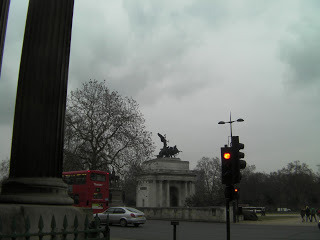
The Wellington Arch!
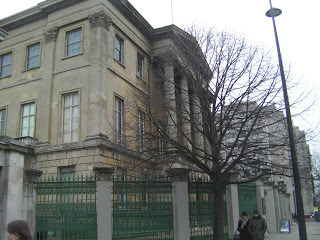
Walking round to the front of Apsley House.
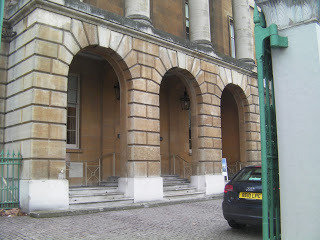
The front of Apsley House.
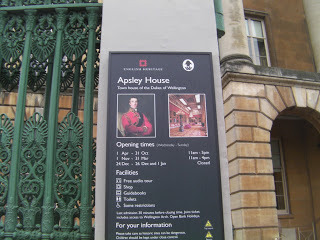
Whoops! Almost forgot to point out the sign.
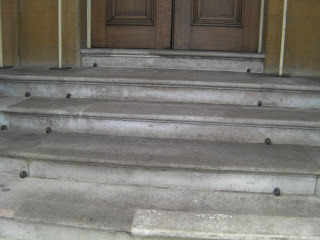
The steps leading up to the front door. Note the black dots going up each side of the steps. A carpet rail would be slid into these iron rings to hold a stair carpet in place during important events. Personally, I think our visit is an important event in itself, but I suppose since we're on first name terms with Artie our visit is considered informal.
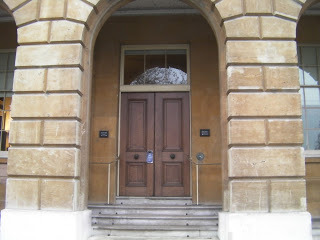
The front door!
Unfortunately, those are all the first hand photos you'll see, as no photography is allowed inside. I was able a scant few photos online, so those will have to do. I can tell you that the two portraits below, both by Thomas Lawrence, hang within.
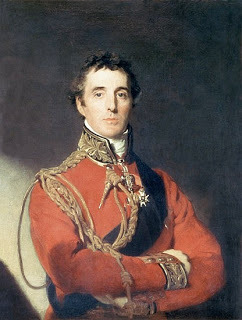
Whilst the portrait above may be the most iconic image of the Duke, I'm also partial to the lesser known and seldom seen portrait below, painted circa 1820.
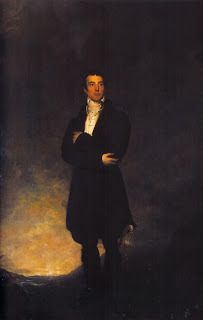
I feel that this painting captures the essence of the Duke as a man, rather than as a great soldier or statesman. He stands alone, in civilian dress and with no emblem of military might, in the semi-darkness ready to defend against whatever comes his way. At the same time, there is something in the way he protectively holds his arms to his chest that evokes an air of vulnerability, a trait not typically attributed to the Duke of Wellington.
Now we'll move on to the Waterloo Chamber, below.
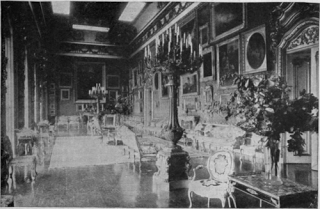
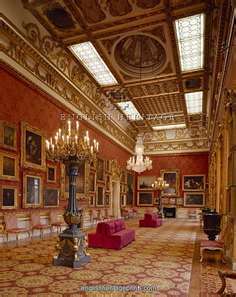
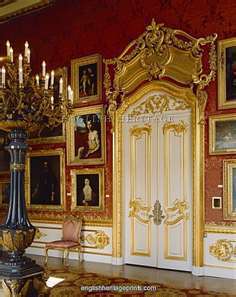
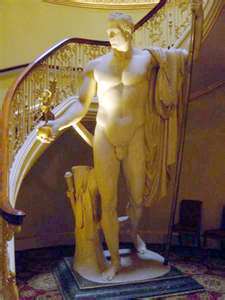
Above is the statue of Napoleon by Canova that was taken as a spoil of war and presented to the Duke of Wellington by George IV. I don't suppose re-gifting was an option then . . . . . .
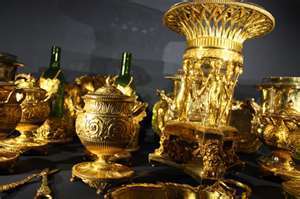
Above is only a tiny portion of the gold plate presented to the Duke by grateful nations and on display at Apsley House. Below is the Portuguese Centrepiece, one of the most important examples of Neo-Classical silver ever made, which was always used during the Duke's annual Waterloo Dinners.
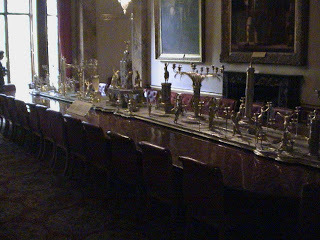
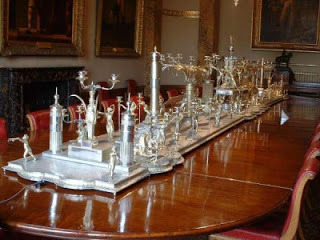
If you're a faithful reader of this blog, you'll know that on one of my previous visits I set off the alarm when I touched the centerpiece, which at that time was covered in a layer of dust. I simply couldn't believe it had been allowed to gather dust and so swiped my finger across it to be sure. I'm happy to report that it's now gleaming and dust-free. So ends our stroll to Apsley House. I hope you've enjoyed as much as I.

Our first glimpses of Apley House through the trees.


The Wellington Arch! And many double decker buses.

We're getting closer.

The gate at Hyde Park Corner, Apsley House and a rare break in the traffic.

The Wellington Arch!

The gates at Hyde Park


Stepping inside the gates, the toll keeper's cottage.

View from inside gates to the side of Apsley House. Wouldn't we look marvelous standing on that balcony with a cocktail in our hand?

The Wellington Arch!

Walking round to the front of Apsley House.

The front of Apsley House.

Whoops! Almost forgot to point out the sign.

The steps leading up to the front door. Note the black dots going up each side of the steps. A carpet rail would be slid into these iron rings to hold a stair carpet in place during important events. Personally, I think our visit is an important event in itself, but I suppose since we're on first name terms with Artie our visit is considered informal.

The front door!
Unfortunately, those are all the first hand photos you'll see, as no photography is allowed inside. I was able a scant few photos online, so those will have to do. I can tell you that the two portraits below, both by Thomas Lawrence, hang within.

Whilst the portrait above may be the most iconic image of the Duke, I'm also partial to the lesser known and seldom seen portrait below, painted circa 1820.

I feel that this painting captures the essence of the Duke as a man, rather than as a great soldier or statesman. He stands alone, in civilian dress and with no emblem of military might, in the semi-darkness ready to defend against whatever comes his way. At the same time, there is something in the way he protectively holds his arms to his chest that evokes an air of vulnerability, a trait not typically attributed to the Duke of Wellington.
Now we'll move on to the Waterloo Chamber, below.




Above is the statue of Napoleon by Canova that was taken as a spoil of war and presented to the Duke of Wellington by George IV. I don't suppose re-gifting was an option then . . . . . .

Above is only a tiny portion of the gold plate presented to the Duke by grateful nations and on display at Apsley House. Below is the Portuguese Centrepiece, one of the most important examples of Neo-Classical silver ever made, which was always used during the Duke's annual Waterloo Dinners.


If you're a faithful reader of this blog, you'll know that on one of my previous visits I set off the alarm when I touched the centerpiece, which at that time was covered in a layer of dust. I simply couldn't believe it had been allowed to gather dust and so swiped my finger across it to be sure. I'm happy to report that it's now gleaming and dust-free. So ends our stroll to Apsley House. I hope you've enjoyed as much as I.
Published on January 20, 2011 01:20
January 19, 2011
Let's Play Telephone

We're putting a new twist on the old game of "Telephone." Instead of seeing how garbled a message becomes as it's passed from ear to ear, we challenge you to create the message. Just think how the availability of the telephone could have changed lives - and history.
Enter our contest by creating a historical telephone call - it can be one sided or two, it can be funny, filled with pathos, earth shattering or just plain amusing. Place your entry by leaving it in the comment section below. Limit is 3 entries per person, each no more than 500 words. The contest is open for one week - until January 26th. On the 27th we'll announce the winner, who will receive books (fiction and non), recent issues of Country Life Magazine and a Country Life wall calendar.
In order to get the ball rolling, here's my own (ineligible) entry - a conversation between Wellington and Blucher:
"Hello? Hello? Blucher? It's Wellington . . . I say, it's the Duke of Wellington . . . I know there's a lot of background noise on my end, old man, but I'm afraid that can't be helped. Listen, where are you? What? I beg your pardon, I had my face buried in Copenhagen's neck when I ducked just then. Can you hear me now? Where are you? Oh, for God's sake man, turn on your GPS! . . . . . that's the ticket. And Blucher? . . . . . Hurry!
Please Note: Only registered followers of this blog shall be eligible to win. You may register now by using the link in the right sidebar under "Those Who Call Number One London Home."
Published on January 19, 2011 00:53
January 18, 2011
Minster Lovell Church and Ruins
So, here we are at St. Kenelm's Church on a cold, wet, foggy December day when our surroundings look for all the world like a Hammer Studios horror movie set. On the day we visited, the air was crisp and cold and the place was as deserted as it looks in the photos below. There was nary a footprint to be seen in the graveyard and it was so quiet that you could hear the snow crunch beneath your boots with each step. . . no one spoke . . . . . no one dared to break the eerie silence as we made our way through the ancient tombstones . . . . . don't be afraid - I'm sure the legends of the Minster Lovell Hall ghost are just rumour . . . . . . . .
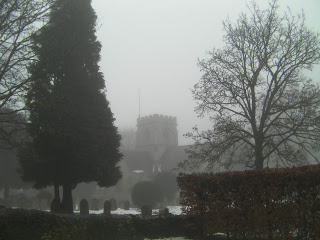
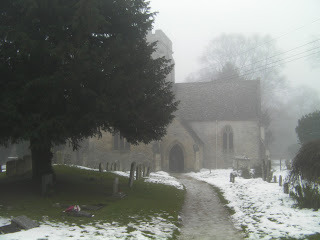
St Kenelm's church in Minster Lovell (above) is mainly 15th century, built on the foundations of an earlier priory minster. This explains the unusual cruciform shape with a central tower. The whole church is "almost entirely unaltered and has handsome details" (Pevsner). It is situated next to the ruins of Minster Lovell Hall, pictured below.
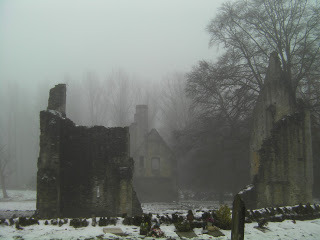
From Kelly's Directory 1891 - To the south-east of the church, near the river Windrush, are the ruins of an ancient mansion, formerly the residence of the Lovell family: the buildings, when perfect, formed a square, the south side being parallel to the river and within a few feet of its bank; the whole of the south and east sides are now destroyed and the only portions standing are the north side, part of a tower at the south end of the western side and a low wall attached to it, with several fine but now roofless and dismantled apartments; in 1708, during the rebuilding of a chimney here, a large vault was discovered in which was found the entire skeleton of a man sitting at a table on which were writing materials and a book and it has been assumed that Lord Lovell, who disappeared after the battle of Stoke, made his way to his house here, and concealing himself in this vault, was eventually starved to death; on his death, his titles, including the baronies of Lovell and Holland, Dean Court and Grey of Rotherfield, became extinct, and that of Beaumont fell into abeyance between his sisters, but was called out 16 Oct. 1840, in favour of Miles Thomas Stapleton esq. of Carlton, Yorks, one of the co-heirs thereto. The estates of the Lovells, confiscated by Henry VII, were subsequently granted to the Comptons, Cecils and other powerful families.
** An alternate version of the story of Lord Lovell is that he returned with his faithful dog to the Hall and was locked into the secret chamber by his faithful valet, who breathed not a word of Lord Lovell's whereabouts to a single soul and who came twice a day to feed his master and his master's dog. The valet, unfortunately, died before he could share his secret with anyone and so Lord Lovell and the faithful dog perished together, starving to death in their self imposed hiding place.
*** Yes, the place is rumoured to be haunted. By both man and dog. And what a perfect location for a ghost, visually. You couldn't get much more Byron-esque if you tried.
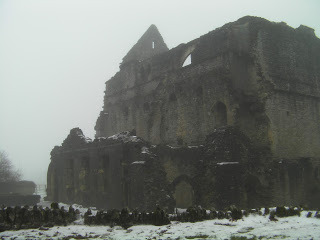
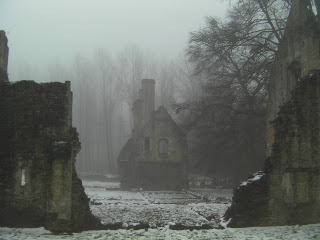
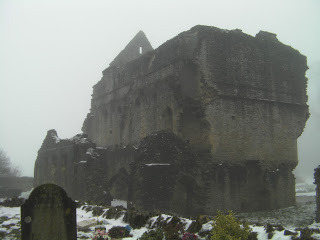
I'll leave you with images that are sure to conjure up visions of Christopher Lee . . . . .
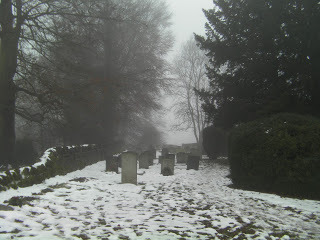
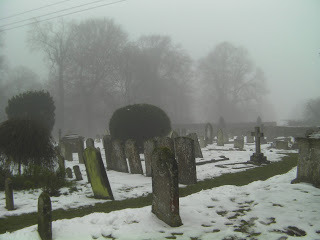
You can view a video of Minster Lovell Hall in the right side bar of this blog to see what it looks like when it's not covered in snow.


St Kenelm's church in Minster Lovell (above) is mainly 15th century, built on the foundations of an earlier priory minster. This explains the unusual cruciform shape with a central tower. The whole church is "almost entirely unaltered and has handsome details" (Pevsner). It is situated next to the ruins of Minster Lovell Hall, pictured below.

From Kelly's Directory 1891 - To the south-east of the church, near the river Windrush, are the ruins of an ancient mansion, formerly the residence of the Lovell family: the buildings, when perfect, formed a square, the south side being parallel to the river and within a few feet of its bank; the whole of the south and east sides are now destroyed and the only portions standing are the north side, part of a tower at the south end of the western side and a low wall attached to it, with several fine but now roofless and dismantled apartments; in 1708, during the rebuilding of a chimney here, a large vault was discovered in which was found the entire skeleton of a man sitting at a table on which were writing materials and a book and it has been assumed that Lord Lovell, who disappeared after the battle of Stoke, made his way to his house here, and concealing himself in this vault, was eventually starved to death; on his death, his titles, including the baronies of Lovell and Holland, Dean Court and Grey of Rotherfield, became extinct, and that of Beaumont fell into abeyance between his sisters, but was called out 16 Oct. 1840, in favour of Miles Thomas Stapleton esq. of Carlton, Yorks, one of the co-heirs thereto. The estates of the Lovells, confiscated by Henry VII, were subsequently granted to the Comptons, Cecils and other powerful families.
** An alternate version of the story of Lord Lovell is that he returned with his faithful dog to the Hall and was locked into the secret chamber by his faithful valet, who breathed not a word of Lord Lovell's whereabouts to a single soul and who came twice a day to feed his master and his master's dog. The valet, unfortunately, died before he could share his secret with anyone and so Lord Lovell and the faithful dog perished together, starving to death in their self imposed hiding place.
*** Yes, the place is rumoured to be haunted. By both man and dog. And what a perfect location for a ghost, visually. You couldn't get much more Byron-esque if you tried.



I'll leave you with images that are sure to conjure up visions of Christopher Lee . . . . .


You can view a video of Minster Lovell Hall in the right side bar of this blog to see what it looks like when it's not covered in snow.
Published on January 18, 2011 01:00
January 17, 2011
A Walk Through Minster Lovell
On one of our day trips out of London, Greg and I took a train to Oxford and the Cotswolds on a London Walks tour. The day was cold, the ground was covered in snow and the view from the train was obscured by heavy fog. After arriving in Oxford, we boarded a private coach for the village of Minster Lovell, located to the west of Oxford. The village is approached via a bridge over the River Windrush.
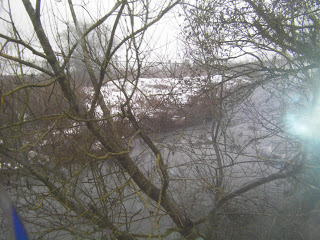
Disembarking, we had time to take in the chocolate box cottages with thatched roofs that line the single main road of the village that will probably never make it to an episode of Midsomer Murder, as apart from the charming houses, there is only a pub, a church and a ruin. Narrative here isn't really necessary . . . . let's just stroll quietly up the frozen road together and admire the view . . . . . .
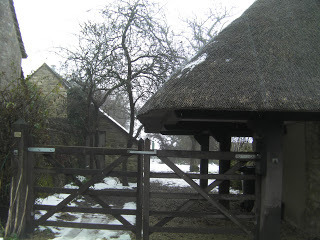
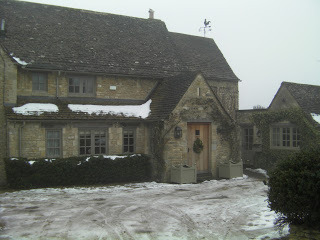
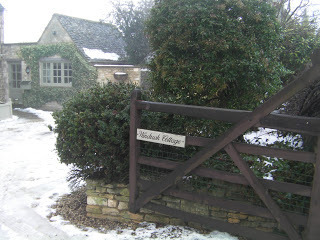
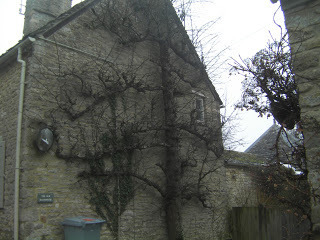
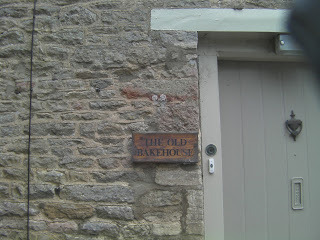
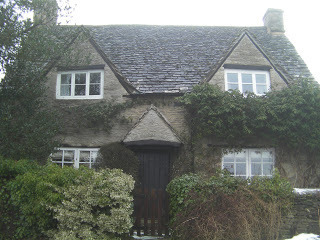
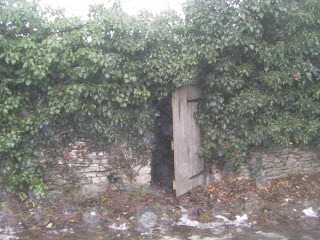
Sigh.
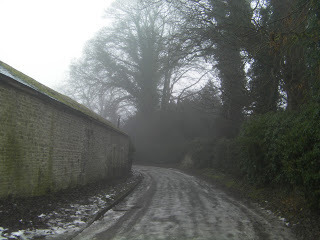
Follow me up this road to the ruins of Minster Lovell Hall and St. Kenelm's Church . . . . . .
Coming Soon

Disembarking, we had time to take in the chocolate box cottages with thatched roofs that line the single main road of the village that will probably never make it to an episode of Midsomer Murder, as apart from the charming houses, there is only a pub, a church and a ruin. Narrative here isn't really necessary . . . . let's just stroll quietly up the frozen road together and admire the view . . . . . .







Sigh.

Follow me up this road to the ruins of Minster Lovell Hall and St. Kenelm's Church . . . . . .
Coming Soon
Published on January 17, 2011 01:37
Downton Abbey - Again
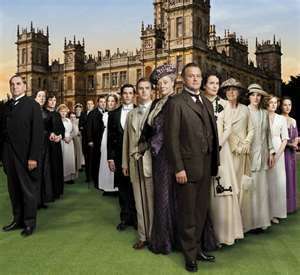
Okay, Episode 2 was much better. Some characters seemed better defined, others were less annoying. I know, I know - I love these period pieces and no one wants to love this one more than me. I don't know what the problem is. I have to say that every time I see either Jim Carter as Mr. Carson
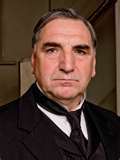
or Brendan Coyle as John Bates
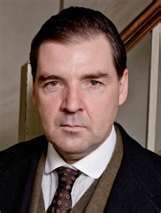
I'm transported back to Lark Rise. Seeing them together in the same scene makes me think that Laura is going to come running into view at any moment.
However, the appearance of Turkish houseguest Kemal Pamuk, played by Theo James, made me think that things were, indeed, picking up. And then he died. Which, as a plot device, was hysterical.
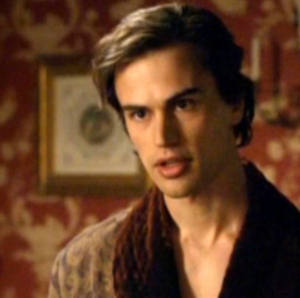
And which prompted Maggie Smith to utter one of the funniest lines so far - "No Englishman would ever dream of dying in someone else's house." Thank goodness I wasn't drinking anything when I heard it.
If you can't wait until the conclusion this Sunday - and I admit that I'm now looking forward to it myself - the ITV website offers exclusvie features, click here. And, of course, you can visit the Masterpiece Theater site, where you can watch the first two episodes again.
Published on January 17, 2011 01:30
Kristine Hughes's Blog
- Kristine Hughes's profile
- 6 followers
Kristine Hughes isn't a Goodreads Author
(yet),
but they
do have a blog,
so here are some recent posts imported from
their feed.



